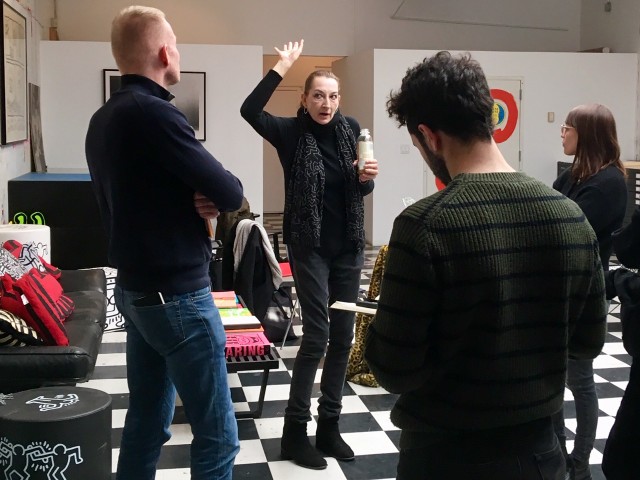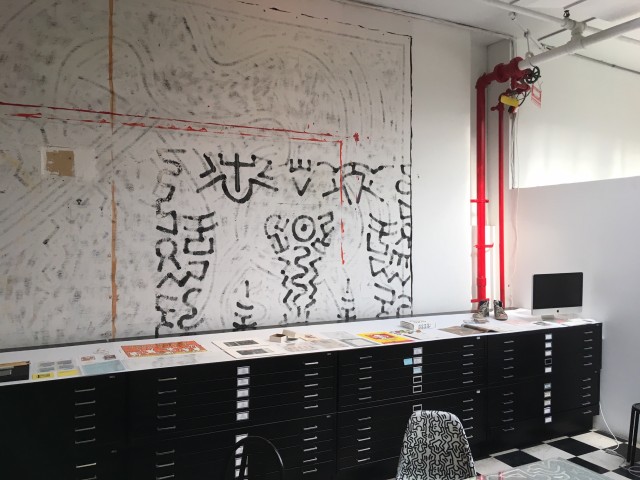“Drawing was his gift.” Keith Haring – Previewed
![Joseph Szkodzinski Keith Haring Drawing Series [02]](http://www.thedoublenegative.co.uk/blog/wp-content/uploads/2019/06/Joseph-Szkodzinski-Keith-Haring-Drawing-Series-02.jpg)
Vibrant, colourful and packed with signs and symbols, Keith Haring’s work resonates to this day. Mike Pinnington recounts meeting his friend, confidant and Executive Director of his Foundation, Julia Gruen…
“I know that I’ll end up somewhere for some reason or no reason, but with some answers or at least be a little clearer on why I am and what I am aiming to do or what I am gonna do or just ‘do.’ If this fate is negative, that isn’t negative because that is what happened and that then was the fate.”
Keith Haring, Journals, 29 April, 1977: Pittsburgh
Whether or not we believe in fate, or that things happen for a reason, there is something about times and places in which people and ideas coalesce, and connections are made: serendipity takes hold. Late 1970s/early 80s New York was just such a place. A different city to the one most of us see in our mind’s eye today, it was grittier and rougher around the edges. Some neighbourhoods were practical no-go zones, rife with violence and crime, and the subway was patrolled by self-appointed Guardian Angels. Edgy isn’t the word. On the flipside, it was affordable, making it a magnet for young creatives, and there were abandoned spaces aplenty, ripe for exploration and repurposing. It was against this backdrop that a boyishly young Keith Haring arrived, aged just 20, from his home of Kutztown, Pennsylvania.
Quickly ensconced there, he wasted little time in putting billboards, advertising hoardings and subway walls to use. A student of graphics at a commercial arts school back home, these readymade public realm canvasses became the testing ground on which Haring could hone his already prodigious talent. Crucially, New York was a place where the young artist felt free to express himself; he found the sense of belonging that small-town, rural USA, had denied him. Enrolling at the School of Visual Arts (SVA) in 1978, he discovered a thriving downtown counterculture. He met and became friends with fellow artists such as Kenny Scharf, and exhibited alongside the likes of Jean-Michel Basquiat, Nan Goldin and Robert Mapplethorpe.
In just a few short years, Haring was established resolutely at the intersection of art, fashion, design and clubbing culture. Enthused by the life he was making for himself, he remarked: “Everything was very exciting, living in Greenwich Village, having my own apartment and going to school. And it was great meeting Kenny Scharf and Jean-Michel Basquiat, who became my friends and also wanted to become artists.” Somebody who knew Haring as well as anybody from that time – and until the end of his life – was Julia Gruen, who became his studio manager in 1984. With a group of other journalists, bloggers and critics, I visited the old studio earlier this year, when Gruen talked about her years working alongside the artist. Now Executive Director of his Foundation, she says: “We moved here in ’85 … it was one long space – painting racks, drawing table. Keith hated mess.”

Despite rising rents, 676 Broadway remains home to The Keith Haring Foundation, set up by the artist in 1989. There are traces of him everywhere. The walls are covered in paint – indelible (if faded) signature signs and symbols – and framed prints, sofas are strewn with Haring merchandise, including barking dog cushions. Referring to those early years in the city which quickly became his home, Gruen said: “He met many of his peers in New York. He made a community for himself here.” This community, of course, extended beyond the art world: “To be a gay man in a small, rural town, wasn’t feasible,” she adds, nodding to the necessity to leave home in search of the rich social life Haring ultimately found in his adopted city.
Indeed, his weekends were sacrosanct, reserved for partying, clubbing and sex. But Monday to Friday, “he was incredibly disciplined, and he worked all the time… He was so determined and so diligent in his work.” Producing an extraordinary amount of drawings in particular, it’s impossible to doubt this picture of dedication – only the most conservative would describe him as simply prolific. On whether he approached drawing and painting differently, Gruen said: “He continually drew – with a particular purpose, or no purpose at all… He would make paintings for exhibition. It wasn’t as if he painted every day. He drew every day… He would be the first to say drawing was his gift – there were no sketches or rough drafts.”

By the middle of the decade, he had had solo shows across Europe, including in Milan, Bordeaux and Amsterdam. Along the way he had also met Andy Warhol, who quickly became his friend and mentor. Haring’s rise, which matched his output, was meteoric. “He embodied a synthesis of youth, energy, America at its best,” Gruen says. Nowhere was this better illustrated than by what she calls his rebelliousness, and “his commitment to the public at large.” Socially and politically aware, Haring became increasingly involved in campaigns challenging apartheid in South Africa, the crack cocaine epidemic in New York, and – even closer to home – to raise awareness of and fight the stigma surrounding AIDS (which he witnessed first-hand amongst friends).
His own AIDS diagnosis came in 1988, and the following year he established the foundation; its remit to provide funding, imagery and support to children’s programmes and organisations combatting the disease. His diagnosis didn’t prevent him from remaining active, however; “He worked here until about two weeks before his death [in 1990],” confirms Gruen. For the first time that day, the mood in the room turns somewhat sombre, most of us stuck for something to say in the face of Haring’s friend recounting the memory aloud. Sensing this, perhaps, she takes a breath, regathers herself: “Don’t ask me what he’d be doing now [but] we assume he’d be working, resisting and protesting.” It’s a short but fitting tribute to her friend, the artist.
Mike Pinnington
See Keith Haring @ Tate Liverpool, 14 June – 10 November 2019
Catch Julia Gruen in conversation with Miranda Sawyer Saturday 15 June, 12pm @ Tate Liverpool
Images from top: Joseph Szkodzinski, Keith Haring Drawing Series, January 1982 © Joseph Szkodzinski; Julia Gruen (centre) at The Haring Foundation, and painted studio wall © Mike Pinnington





